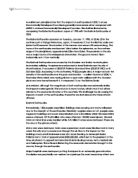A well-known principle states that the impact of earthquakes in LEDC’s or Less Economically Developed Countries is generally more severe when compared with MEDC’s or More Economically Developed Countries. This shall be illustrated by comparing the Kobe Earthquake in Japan of 1995 with the Kashmir Earthquake of 2005.
The Kobe Earthquake occurred on Tuesday, January 17, 1995, at 05:46 JST in the southern part of Hyōgo Prefecture, Japan. It measured 7.2 on the Richter scale and lasted for 20 seconds. The duration of the tremors was around 20 seconds long. The focus of the earthquake was located 16km below the epicentre, on the northern edge of the Awaji Island, approximately 20km from Kobe. The proximity to the city was a major factor of its widespread devastation. The ground moved 18cm horizontally and 12 cm vertically.
The Kashmir Earthquake was caused by the Eurasian and Indian tectonic plate boundaries colliding. Its epicentre was located in Azad Kashmir near the city of Muzaffarabad. It occurred at 08:52:37 Pakistan Standard Time (03:52:37 UTC) on 8 October 2005. According to the authorities, 79000 people died. A major factor in the severity of the earthquake was the poor construction – a salient feature of LEDC’s. The Indian Plate which was moving 40 mm a year north collided with the Eurasian plate and was forced beneath it. It measured 7.6 on the Richter Scale.
As is evident, although the magnitude of both earthquakes was extremely similar, the impacts varied greatly. This was due to many factors, which most if not all are related to the economic situation of the countries. We shall begin by discussing the impacts of each of the earthquakes, thereafter we shall discuss why these effects differed.
Kashmir Earthquake
Immediately, 1400 people were killed. Buildings were swaying and many collapsed due to the strength of the earthquake. Electricity supplies were cut off, people were trapped in buildings and roads were blocked due to landslides which hindered initial rescue attempts. Of the 8 million who were affected, 100,000 were injured. Several trains on minor lines were derailed while 3.3 million homes were destroyed. These are the crux of the primary effects.

This is a preview of the whole essay
Teacher Reviews
Here's what a teacher thought of this essay
Overall a good review of the impacts resulting from two similar earthquakes. Some weaknesses in the structuring of the essay but otherwise very good. 4 stars
Peer Reviews
Here's what a star student thought of this essay
Quality of writing
I only found one punctuation mistake which was a capital letter on the word 'ignorance' when it wasn't the beginning of the sentence. I find this shocking in a piece of work that has been completed to such a high level. Such shows the lack of proof reading and just proof reading for the sense rather than looking deeper and checking spelling, grammar and punctuation. The technical terms were used accurately, however a further definition of MEDC and LEDC is needed to show the examiner that the student understands the classification for the two. Also, I would say that it is correctly written as MEDCs rather than MEDC's and LEDCs rather than LEDC's. I do not think that the short paragraphs work well either. One sentence cannot count as one paragraph and would suggest the student re-look at the how to formulate paragraphs. Other than this, the piece was well structured and logically written.
Level of analysis
The student offers the typical level of analysis here. I would not say that this has lowered the student's mark at all as this student has included most things that would ensure that they scored the highest possible marks. However, it does not make the student's work stand out from the crowd. Having said this, their response was clear and well developed and a strong and valid conclusion was reached with strong supporting figures.
Response to question
The student shows a clear understanding of the set question with their strong introduction and conclusion. Both clearly introduce and conclude their idea in a coherent and logical manner. The student has considered many different aspects of that would contribute to the difference between natural disasters in LEDCs and MEDCs and supports their statements with relevant material. However, I would suggest that they could highlight the difference in technology more. Such that even the earthquake in Kashmir in 2005 (around 10 years after Kobe), hit Kashmir worse than Kobe in spite of the advancement of technology in that 10 year gap. Such attention to detail would really show the examiner the level of understanding of the student and almost ensure that full marks are gained.







